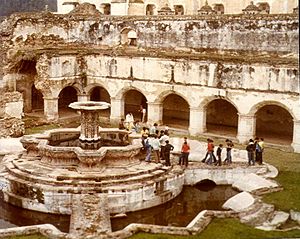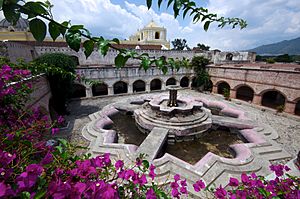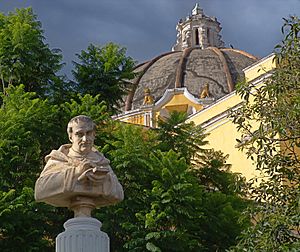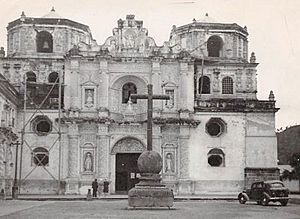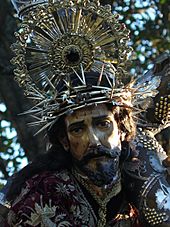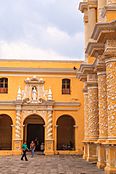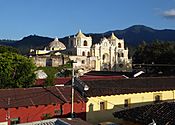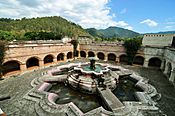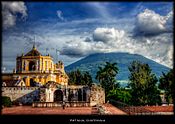Iglesia de La Merced, Antigua Guatemala facts for kids
Quick facts for kids Convent of the Mercedarians |
|
|---|---|
|
Iglesia y convento de Nuestra Señora de Las Mercedes
Convento e Iglesia de La Merced (Spanish) |
|
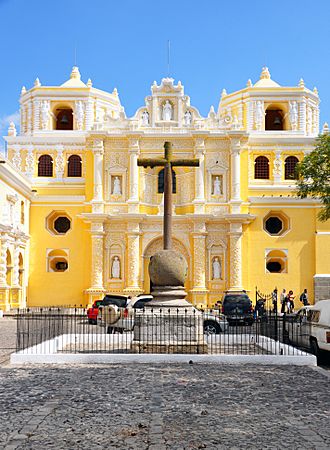
Main facade
|
|
| General information | |
| Status | Active church |
| Architectural style | Spanish seismic baroque |
| Location | Antigua Guatemala, |
| Coordinates | 14°33′42.016″N 90°44′3.649″W / 14.56167111°N 90.73434694°W |
| Construction started | 1751 |
| Completed | 1767 |
| Owner | Secular clergy |
| Design and construction | |
| Architect | Juan de Dios Estrada |
The Church and Convent of La Merced is a beautiful Catholic church in Antigua Guatemala, Guatemala. A talented architect named Juan de Dios Estrada started building it in 1749. The church officially opened its doors in 1767.
Contents
Exploring La Merced Church
This church has a special style called Guatemalan Churrigueresque, which means it has lots of fancy decorations. It has two tall bell towers. On the front of the church, you can see a sculpture of St. Peter Nolasco. He was the person who started the Mercedarian Order. Below him, there's a statue of the Virgin of Mercy and the Mercedarian shield.
On the left side of the church's front, there are sculptures made of stucco and brick. These show St. Raymond Nonnatus and St. Pedro Armengol. On the right side, you'll find St. Peter Pascual and St. Mary de Cervellione. She was the very first Mercedarian nun.
The Giant Fish Fountain
The "Fountain of los Pescados" (Fish Fountain) was built in the 1700s. It's one of the biggest colonial fountains in Latin America, measuring about 27 meters (88 feet) across! The fountain looks like a water lily, which is a common flower in Guatemala's lowlands. For the ancient Maya, the water lily was a symbol of creation. They believed a god created a water lily, and then other gods came from it.
A Look at History
The Mercedarian Order came to Central America with the Spanish explorers. Friar Marcos Dardón was one of the first Mercedarians in Guatemala around 1537. The Mercedarians first settled in the Almolonga Valley. After a big landslide from the Volcán de Agua Volcano, they moved to the Panchoy Valley.
The Mercedarians helped spread the Catholic faith in many areas. They had many missions in places that are now the Guatemalan departments of Quetzaltenango, San Marcos, and Huehuetenango. They also helped start churches in Honduras.
In 1561, the Mercedarian province of Our Lady of the Mercy of Guatemala was created. This included Guatemala, Honduras, San Salvador, Nicaragua, and Costa Rica. The Mercedarians also owned sugar mills and built the San Gerónimo School. However, this school was taken by the government in 1763.
In 1761, a new leader named Alonso Fernández de Heredia arrived. He gave four thousand pesos to help build the Iglesia de la Merced. The church was finished in 1767. It was built using new techniques that helped it survive the big Santa Marta Earthquakes just six years later.
Changes by the Spanish Crown
In the mid-1700s, the Spanish king made some big changes called the Bourbon reforms. These changes aimed to give the king more power over the colonies and collect more taxes. They also wanted to reduce the power of the Catholic Church.
The king's plan to lessen the Church's power had several parts:
- They wanted to reduce the influence of the Jesuits, another religious group.
- They encouraged a more modern way of thinking, focusing on science and reason.
- They questioned the Church's role in society.
- They promoted the idea that the king had authority over the Church in his lands.
The Santa Marta Earthquakes
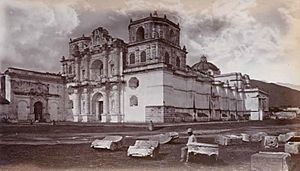
In 1773, the city of Santiago de los Caballeros de Guatemala was badly damaged by the Santa Marta earthquakes. But the Church of Nuestra Señora de las Mercedes, also known as "Oratorio de la Merced," was almost new. It didn't suffer much damage and stayed open for worship. Its statues and altars were safe.
To make people move to the new capital city, the government ordered important statues to be moved. In 1778, the statue of Jesús Nazareno de la Merced and the Virgin were moved. This was a sad event for the people of Antigua. They cried and prayed as the statue left. The statue traveled a long way to Nueva Guatemala de la Asunción. In 1801, the altar for the statue was also moved. The Mercedarian church in the new city opened in 1813.
Meanwhile, the old city of Santiago was called "ruined Guatemala" or "old city." It was mostly abandoned by officials. But the Church of La Merced continued to serve the community. Later, the parish of San Sebastián moved into the Mercedarian church, and it has been there ever since.
Moving the Jesús Nazareno Statue
In 1776, the capital city was moved to Nueva Guatemala de la Asunción. This happened after the Santa Marta earthquakes of 1773 damaged Santiago de los Caballeros de Guatemala. The government used this chance to weaken the power of the Church. They forced religious orders to move from their large convents to temporary buildings in the new city.
The Second Jesús Nazareno Statue
After the first Jesús Nazareno statue was moved in 1778, the Church of La Merced in Antigua didn't have a Nazarene statue. To prevent more problems, the authorities decided to leave the Jesús Nazareno statue from the San Jerónimo hermitage in Antigua Guatemala. This statue was moved to the San Sebastián parish in 1804. Then, it was finally moved to the Iglesia de la Merced. It has been there ever since and is now a very important part of Holy Week in Antigua Guatemala.
Tourism and Pilgrimage
Brother Pedro's Route
"Visiting the places where Saint Brother Pedro walked and knowing his legacy such as social works, is part of the learning of the pilgrimage. The “Pilgrim Route” allows one to experience a different way of getting to know Antigua Guatemala”.
The Church of Nuestra Señora de las Mercedes is a stop on the Brother Pedro Commemorative Tourist Route. This route lets you explore Antigua Guatemala by following the life and work of Brother Pedro.
This special route includes visits to places like Pedro Armengol's looms, the monument to Brother Pedro, the Arch del Matasanos, the Hospital Real de Santiago, Brother Pedro's tomb in the Church of San Francisco, and the Convent of la Compañía de Jesus.
Holy Week Celebrations
Holy Week processions in Guatemala are a huge attraction in Antigua Guatemala. From La Merced, two famous processions walk through the streets during Holy Week. These traditions have been kept alive for many centuries. Many of the original statues used in these processions are now in Guatemala City.
Here are some of the processions that leave from churches in the city and nearby towns:
| Day | Image | Schedule |
|---|---|---|
| Palm Sunday | Jesús Nazareno de la Merced in His Review Procession | 08:30 a. m. – 11:00 p. m. |
| Holy Thursday | Jesús Nazareno del Perdón of the Iglesia de San Francisco, Antigua Guatemala | 12:00 p. m. – 11:00 p. m. |
| Holy Thursday | Jesús Nazareno de la Humildad of the Church San Cristóbal el Bajo | 11:00 a. m. – 11:00 p. m. |
| Holy Friday | Jesús Nazareno de la Merced in its Procession of Penance | 4:00 a. m. – 3:00 p. m. |
| Holy Friday | Holy Burial with the C.I of the Buried Lord and Holy Mary of Solitude of the Church School de Cristo | 4:00 p. m. – 2:00 a. m. |
| Holy Friday | Procession of the Buried Lord of the Church of San Felipe de Jesús. | 3:00 p. m. – 6:00 a. m. |
Image Gallery
-
Volcán de Agua Volcano and La Merced church
See also
 In Spanish: Iglesia de La Merced (Antigua Guatemala) para niños
In Spanish: Iglesia de La Merced (Antigua Guatemala) para niños


